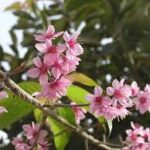
In the intricate dance between nature and adaptation, Rosa Canina stands as a resilient symbol of botanical fortitude. However, as our environment undergoes transformations, driven by natural forces and human activities, the delicate balance that sustains Rosa Canina’s ecosystem is increasingly challenged. In this discourse, we delve into the intricate interplay between natural environmental changes and Rosa Canina, unraveling the research findings, and advocating for protective measures to safeguard this botanical treasure.
#### Understanding the Dynamics of Natural Environmental Changes
Natural environmental changes encompass a spectrum of phenomena, from gradual shifts in climate patterns to sudden disturbances triggered by geological events:
– **Climate Fluctuations**: Rosa Canina habitats are subject to fluctuations in temperature, precipitation, and humidity, influencing plant growth, reproduction, and distribution. Climate change exacerbates these fluctuations, leading to altered phenological cycles, habitat fragmentation, and biodiversity loss.
– **Extreme Weather Events**: Intense storms, droughts, wildfires, and floods pose immediate threats to Rosa Canina populations, disrupting ecosystems, causing habitat destruction, and triggering soil erosion. These extreme events challenge the resilience of Rosa Canina, jeopardizing its survival and ecological role.
– **Geological Processes**: Geological processes, such as volcanic eruptions, seismic activities, and soil erosion, shape Rosa Canina landscapes and soil composition. However, human-induced activities, such as deforestation, mining, and urbanization, accelerate soil degradation, habitat degradation, and biodiversity decline.
#### Navigating the Impact of Natural Environmental Changes on Rosa Canina
Research studies offer valuable insights into the response of Rosa Canina to natural environmental changes:
– **Phenological Shifts**: Observational studies document shifts in Rosa Canina’s phenological events, including flowering, fruiting, and seed dispersal, in response to changing environmental cues. These phenological shifts affect plant-pollinator interactions, seed viability, and ecosystem dynamics, with cascading effects on biodiversity and ecosystem services.
– **Population Dynamics**: Population ecology studies reveal fluctuations in Rosa Canina populations in response to habitat degradation, climatic stressors, and invasive species competition. Long-term monitoring efforts provide data on population trends, genetic diversity, and adaptive strategies, informing conservation interventions and management practices.
– **Physiological Responses**: Physiological studies elucidate Rosa Canina’s adaptive mechanisms to environmental stressors, including changes in photosynthetic activity, water-use efficiency, and biochemical composition. These physiological responses enhance Rosa Canina’s resilience to drought, heat, and nutrient limitations, enabling it to thrive in diverse habitats.
#### Mitigating the Impact: Strategies for Protecting Rosa Canina
To mitigate the impact of natural environmental changes on Rosa Canina, proactive conservation and management strategies are essential:
– **Habitat Restoration**: Restoring degraded Rosa Canina habitats through reforestation, revegetation, and habitat connectivity initiatives enhances ecosystem resilience and promotes species recovery. By creating corridors for species migration and dispersal, habitat restoration efforts facilitate gene flow and population viability.
– **Climate Adaptation**: Implementing climate-smart conservation measures, such as assisted migration, seed banking, and ex situ conservation, helps Rosa Canina populations adapt to changing climatic conditions. By preserving genetic diversity and adaptive traits, climate adaptation strategies increase the resilience of Rosa Canina to future environmental challenges.
– **Community Engagement**: Engaging local communities, indigenous peoples, and stakeholders in conservation planning and decision-making fosters stewardship and promotes sustainable resource management. By integrating traditional ecological knowledge with scientific expertise, community-based conservation initiatives enhance the effectiveness and legitimacy of conservation efforts.
#### Collaborative Research and Monitoring: Shaping Future Conservation Efforts
Collaborative research and monitoring programs play a pivotal role in understanding the complex interactions between natural environmental changes and Rosa Canina:
– **Long-term Studies**: Long-term ecological research initiatives provide valuable data on the ecological dynamics of Rosa Canina ecosystems, enabling scientists to track trends, detect anomalies, and assess the efficacy of conservation measures over time.
– **Citizen Science**: Citizen science programs engage volunteers in data collection, monitoring, and reporting activities, expanding the spatial and temporal coverage of ecological studies and fostering public participation in conservation efforts.
– **Interdisciplinary Approaches**: Interdisciplinary research collaborations bring together experts from diverse fields, including ecology, climatology, hydrology, and social sciences, to address complex conservation challenges holistically. By integrating multiple perspectives and methodologies, interdisciplinary approaches enhance the robustness and relevance of conservation science.
#### Advocating for Rosa Canina’s Future: A Call to Action
As stewards of our natural heritage, we have a collective responsibility to protect and preserve Rosa Canina and its ecosystems for future generations:
– **Policy Advocacy**: Advocating for policies and regulations that promote habitat conservation, biodiversity protection, and sustainable land use practices is crucial for safeguarding Rosa Canina and other vulnerable species. By advocating for environmental policies that prioritize conservation and sustainability, we can ensure a brighter future for Rosa Canina and its ecological companions.
– **Education and Outreach**: Educating the public, policymakers, and stakeholders about the importance of Rosa Canina conservation fosters awareness, appreciation, and support for conservation initiatives. By raising awareness about the ecological value, cultural significance, and intrinsic beauty of Rosa Canina, we inspire collective action and commitment to its protection.
– **Collaborative Partnerships**: Building partnerships and alliances among government agencies, non-governmental organizations, research institutions, and local communities fosters synergistic collaboration and collective action towards common conservation goals. By pooling resources, expertise, and networks, collaborative partnerships amplify the impact of conservation efforts and promote shared stewardship of Rosa Canina’s natural heritage.
### Navigating Environmental Challenges: Safeguarding Rosa Canina Amidst Natural Environmental Changes
Continuing our exploration of Rosa Canina’s resilience in the face of environmental shifts, we delve deeper into the intricate relationship between natural environmental changes and this botanical marvel. Through scientific inquiry and conservation efforts, we strive to understand and mitigate the impact of environmental transformations on Rosa Canina, ensuring its continued survival and ecological vitality.
#### Unraveling the Complexities: Research Insights into Rosa Canina’s Response to Environmental Changes
Research studies offer invaluable insights into how Rosa Canina navigates and adapts to natural environmental changes:
– **Genetic Diversity**: Genetic studies reveal the importance of genetic diversity in Rosa Canina populations for adaptation to changing environmental conditions. High genetic variability enhances the species’ resilience to environmental stressors, enabling it to evolve and persist in diverse habitats.
– **Phenotypic Plasticity**: Observational and experimental studies demonstrate Rosa Canina’s phenotypic plasticity, whereby individuals exhibit adaptive variations in morphology, physiology, and behavior in response to environmental cues. Phenotypic plasticity enables Rosa Canina to thrive across a range of environmental gradients and ecological niches.
– **Microbial Symbiosis**: Research on microbial symbionts associated with Rosa Canina roots, such as mycorrhizal fungi and nitrogen-fixing bacteria, elucidates their role in enhancing plant resilience to environmental stressors. These beneficial microorganisms facilitate nutrient uptake, improve soil structure, and confer tolerance to drought, salinity, and pathogens.
#### Assessing Vulnerabilities: Identifying Threats to Rosa Canina’s Habitat and Survival
Natural environmental changes pose myriad threats to Rosa Canina and its ecosystems:
– **Habitat Loss and Fragmentation**: Urbanization, agricultural expansion, and infrastructure development encroach upon Rosa Canina habitats, leading to habitat loss, fragmentation, and isolation. Fragmented habitats reduce genetic connectivity, limit dispersal opportunities, and increase susceptibility to edge effects and invasive species.
– **Climate Extremes**: Extreme weather events, such as heatwaves, droughts, and storms, exacerbate climate-related stressors on Rosa Canina populations. Heat stress disrupts reproductive cycles, reduces seed viability, and compromises plant fitness, while drought-induced water scarcity impairs growth, survival, and regeneration.
– **Invasive Species**: Invasive plants, animals, and pathogens outcompete native species for resources, alter ecosystem dynamics, and disrupt mutualistic interactions essential for Rosa Canina’s survival. Invasive species introduce novel diseases, predation pressures, and habitat modifications, exacerbating ecological imbalances and biodiversity loss.
#### Conservation Strategies: Safeguarding Rosa Canina’s Future in a Changing Environment
Effective conservation strategies are essential for protecting Rosa Canina and its ecosystems from the impacts of natural environmental changes:
– **Protected Areas**: Establishing and expanding protected areas, nature reserves, and wildlife corridors safeguard critical habitats and biodiversity hotspots inhabited by Rosa Canina. Protected areas provide refuge for endangered species, preserve genetic diversity, and buffer ecosystems against anthropogenic pressures.
– **Habitat Restoration**: Implementing habitat restoration projects, such as native vegetation restoration, wetland rehabilitation, and riparian zone protection, restores degraded ecosystems and enhances Rosa Canina habitat quality and resilience. Habitat restoration efforts rebuild ecological connectivity, improve water quality, and mitigate habitat fragmentation.
– **Species Monitoring**: Conducting systematic monitoring and surveys of Rosa Canina populations, distribution ranges, and ecological interactions informs conservation planning and adaptive management strategies. Species monitoring programs track population trends, detect emerging threats, and evaluate the effectiveness of conservation interventions.
– **Community Engagement**: Engaging local communities, indigenous peoples, and stakeholders in conservation education, capacity-building, and participatory decision-making fosters stewardship and ownership of conservation initiatives. Community-based conservation approaches empower local communities to manage natural resources sustainably, conserve biodiversity, and adapt to environmental changes.
#### Leveraging Science and Technology: Innovations in Rosa Canina Conservation
Cutting-edge technologies and interdisciplinary approaches hold promise for enhancing Rosa Canina conservation efforts:
– **Remote Sensing**: Remote sensing techniques, such as satellite imagery, LiDAR, and drones, provide spatial data on habitat extent, vegetation cover, and land use changes, facilitating habitat mapping, monitoring, and assessment. Remote sensing enables conservationists to prioritize conservation actions, identify conservation targets, and monitor habitat dynamics at landscape scales.
– **Genomic Tools**: Genomic sequencing, molecular markers, and population genomics analysis enhance our understanding of Rosa Canina’s genetic diversity, population structure, and adaptive potential. Genomic tools aid in identifying evolutionarily significant units, assessing population health, and guiding breeding programs for conservation purposes.
– **Citizen Science Platforms**: Citizen science platforms, mobile apps, and online portals engage citizen scientists in data collection, species monitoring, and ecological research, augmenting traditional scientific efforts. Citizen science initiatives promote public participation in conservation activities, raise environmental awareness, and democratize scientific knowledge.
#### Collaborative Action: Forging Partnerships for Rosa Canina Conservation
Collaborative partnerships and international cooperation are essential for addressing transboundary conservation challenges and achieving conservation goals:
– **Multilateral Agreements**: International agreements, conventions, and protocols, such as the Convention on Biological Diversity (CBD) and the Ramsar Convention on Wetlands, provide frameworks for collaborative action and shared responsibility in conserving Rosa Canina and its habitats. Multilateral agreements foster information exchange, capacity-building, and resource mobilization for conservation initiatives.










